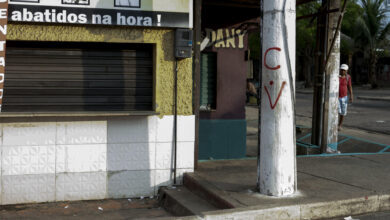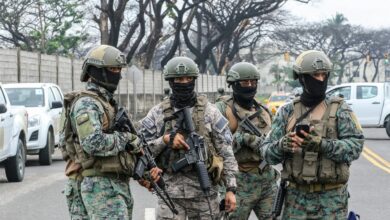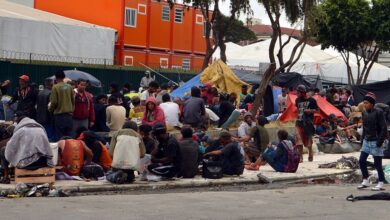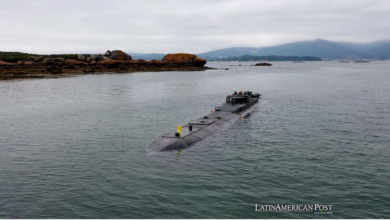Italian Mafia Drug Trafficker Caught in After Photo by Escobar’s Grave in Colombia
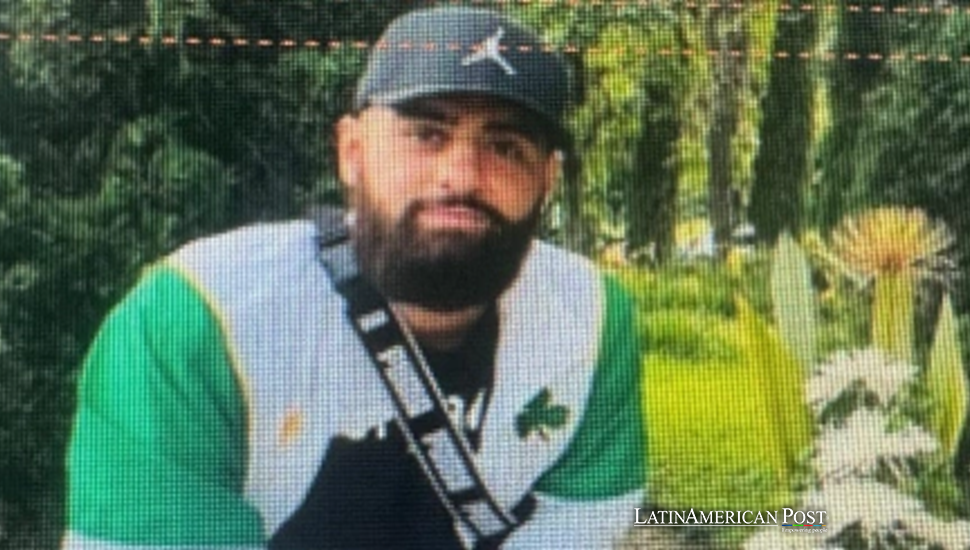
After a relentless pursuit spanning nearly four years, Luigi Belvedere, a notorious Italian mafia fugitive with deep ties to Colombia’s drug networks, has been apprehended. His capture not only marks a significant victory in the fight against transnational crime but also underscores the crucial role of international cooperation in law enforcement. This arrest sheds light on the deadly alliances between Italy’s Casalesi clan and Pablo Escobar’s Colombian drug empire.
A Fugitive’s South American Hideout
After almost four years on the run, Luigi Belvedere, a high-ranking member of Italy’s Casalesi clan, was captured in Medellín, Colombia—a city with a dark legacy as the former base of Pablo Escobar’s infamous drug empire. Belvedere, one of Italy’s most-wanted fugitives, had eluded authorities since 2020 when he was sentenced to nearly 19 years in prison for drug trafficking. He was arrested in the same city where Escobar, one of history’s most powerful drug lords, operated his empire, symbolizing the deep connections between Italian and Colombian crime syndicates.
Italian police released a photograph of Belvedere beside Escobar’s tomb—a chilling nod to his connections with the Colombian underworld. Even in hiding, Belvedere continued his work coordinating massive shipments of cocaine from South America to Europe, exploiting his deep connections with Colombia’s drug cartels. His role as a crucial link between Italian mafia clans and Colombian producers exemplifies the global nature of drug trafficking and how these organizations collaborate across borders to control the global drug trade.
A Fugitive’s South American Hideout
Luigi Belvedere’s arrest in Medellín was the culmination of a coordinated investigation between Italian and Colombian authorities, with support from Europol. Despite being a wanted man, Belvedere managed to integrate himself into Medellín’s criminal underbelly, using his connections to maintain an active role in trafficking cocaine to Europe. His capture not only highlights the continued allure of Medellín for those in the drug trade but also the persistence and resilience of criminal activities, even decades after the fall of Escobar’s empire.
Belvedere’s ties to both the Italian and Colombian drug worlds placed him in a unique position to facilitate the flow of cocaine into Europe. On this continent, demand for the drug remains high. Authorities believe he was responsible for arranging large shipments, relying on the existing infrastructure established by Colombian contacts. The image of Belvedere beside Escobar’s tomb serves as a symbolic reminder of the connection between modern-day traffickers and the infamous legacy of Escobar’s Medellín cartel.
Casalesi Clan: Italy’s Ruthless Camorra Syndicate
Belvedere’s criminal activities in Colombia were deeply rooted in his affiliation with the Casalesi clan, one of the most powerful branches of Italy’s Camorra. The Camorra, a Neapolitan mafia-like organization, has a long and bloody history, with roots dating back to the 19th century. Unlike Sicily’s Cosa Nostra, the Camorra is known for its decentralized structure, which has allowed various clans like the Casalesi to grow and expand their influence independently. Based in Caserta, near Naples, the Casalesi clan has earned a reputation for its brutality and business acumen, particularly in drug trafficking, extortion, and arms smuggling.
The Casalesi clan has been especially notorious in Italy for its use of violence to control local communities and enforce its dominance. Known for employing brutal methods, including intimidation, kidnappings, and murders, the Casalesi clan does not hesitate to target anyone perceived as a threat. Members of the clan have been implicated in high-profile attacks on both rivals and law enforcement, including the assassination of politicians and journalists who opposed them. Their ruthless tactics have spread fear across southern Italy, with victims often left too terrified to report crimes.
The Casalesi’s involvement in the international drug trade, particularly their connections to Colombian suppliers, has further solidified their position within the Camorra’s hierarchy. As a prominent figure within the clan, Belvedere played a crucial role in facilitating these relationships. By serving as a bridge between Italy and Colombia, he ensured a steady supply of cocaine into Europe, helping the Casalesi amass significant profits and expand their influence across the continent. His capture is a significant blow to the clan. Still, it also underscores the ongoing threat posed by their international operations.
Pablo Escobar and the Global Drug Trade
Medellín, where Belvedere was apprehended, was once synonymous with Pablo Escobar’s notorious drug empire. During the height of his power, Escobar controlled the Medellín cartel, which supplied around 80% of the global cocaine market in the 1980s and early 1990s. Escobar’s reach extended beyond Colombia, infiltrating the United States, Europe, and other parts of the world. Known as “El Patrón,” Escobar’s control over the drug trade was so absolute that he became one of the world’s wealthiest men, even landing on Forbes’ billionaire list for seven years.
The Medellín cartel, under Escobar’s rule, operated with a level of sophistication and ruthlessness that set a new standard for organized crime. Escobar’s tactics included bribery, intimidation, and brutal violence. He was responsible for a wave of murders, including the assassination of judges, politicians, journalists, and even civilians who dared to oppose him. His ability to evade capture and his willingness to go to any lengths to maintain control made him one of Colombia’s most feared and influential figures.
The legacy of Escobar’s empire endures, with Medellín still a focal point for drug trafficking networks. Even after Escobar’s death in 1993, the infrastructure he built for cocaine production and distribution continued to be used by Colombian traffickers and their international partners. Today, new players have taken up the mantle, and alliances with international crime groups, like the Camorra, are a crucial component of these operations. Belvedere’s capture in Medellín serves as a stark reminder of the ongoing influence of Escobar’s legacy on the global drug trade, as well as the city’s continued role as a hub for cocaine trafficking.
International Collaboration Leads to Capture
The arrest of Belvedere underscores the ongoing challenges in combating global crime syndicates, particularly those involved in drug trafficking. Europol’s critical role in his capture, collaborating with Colombian authorities and Italian police to track Belvedere’s movements and bring him to justice, highlights the urgency and importance of cross-border partnership in addressing these transnational crime networks.
“Belvedere was a high-value target for us,” Italian police said in a statement to the BBC. “His capture represents a significant disruption to the Casalesi clan’s drug trafficking network.” According to law enforcement, the Colombian police’s involvement was invaluable in locating Belvedere, who had blended into Medellín’s underworld with the help of local contacts. Europol’s support, including advanced tracking technologies, helped close in on the fugitive after years of pursuit.
Belvedere’s case underscores law enforcement’s difficulties when tracking fugitives with ties to global crime networks. Criminals like Belvedere often exploit legal loopholes, bribe local officials, or change identities to evade authorities. As long as the demand for illegal drugs remains high, figures like Belvedere will continue to exploit these networks, making international collaboration crucial for enforcement.
Beyond Belvedere, countless other operatives work within these syndicates, both in Italy and abroad. This capture is one victory in a much larger war for the authorities. The connections between Italian mafia organizations and South American drug cartels are deep-rooted, with both sides benefiting immensely from the collaboration. The Italian government has vowed to continue its fight against these organizations, focusing on dismantling the infrastructure that enables them to operate across borders.
An Ongoing Battle Against Organized Crime
The capture of Luigi Belvedere is a testament to the power of international collaboration and the determination of law enforcement agencies to bring criminals to justice, regardless of where they may hide. His capture in Medellín—a city symbolically linked to Pablo Escobar’s legacy—reinforces the enduring influence of the drug trade and the alliances between crime syndicates spanning continents.
Both the Casalesi clan, a branch of the Camorra, and Colombia’s drug networks share a common interest: profit at any cost. Figures like Belvedere, who serve as intermediaries, facilitate the flow of narcotics across borders and ensure a steady supply of drugs reaches European markets. While Belvedere’s capture is a notable success, the fight against organized crime is far from over. The drug trade remains resilient, fueled by global demand and perpetuated by adaptable and resourceful alliances.
Also read: Ecuador’s Armed Forces Reclaim Confiscated Weapons to Combat Crime
The arrest of a single figure, however prominent, is only a small step toward dismantling these networks. The global community must remain vigilant, employing advanced technology and collaborative policing to tackle this ever-evolving threat. If criminal organizations find refuge and opportunities in cities like Medellín, the battle against the drug trade will continue. Law enforcement will struggle to disrupt the operations that drive this lucrative and deadly industry.

